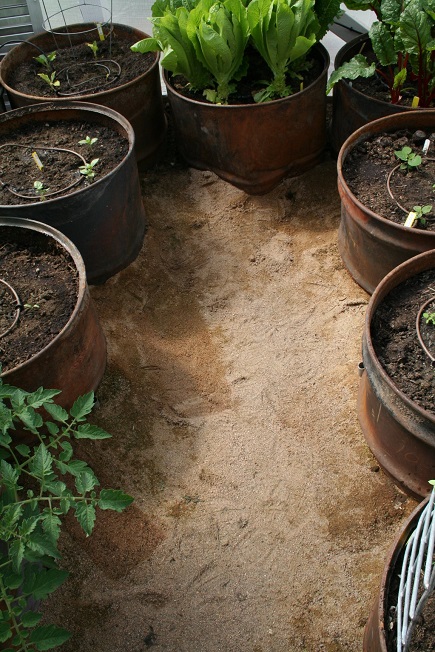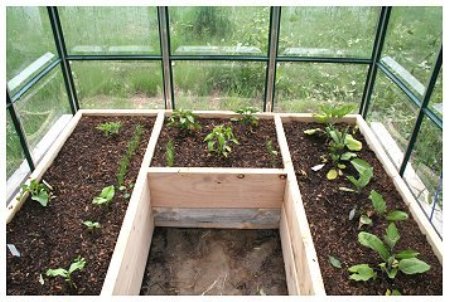
Whether you are using passive or active solar heating systems, the key to energy absorption, storage and release is making good use of thermal mass. Think of thermal mass as a storage battery for heat; the greater the mass, the more capacity we have to absorb and store thermal energy, and that means the more we’ll have to release and put to use after the sun goes down. Thermal mass can take many forms. Let’s take a look at what thermal mass is and how we might create it in our own greenhouses.
When it comes to thermal mass, we need to look at three factors: absorption, capacity and emissivity. For a better understanding, let’s make an analogy with a motor vehicle battery. It’s very much the same concept at work – we’re trying to charge it up, store a charge, and release stored energy when we need it. Absorption is the ability to gather heat – like charging a battery. Capacity is the amount of heat that can be stored – much like the ampere hour rating of a battery. And, emissivity is the ability to give up heat – just like having tight connections on a battery that promotes power flow to operate electric devices.
What we’re looking for in thermal mass is a large capacity, deep discharge “thermal battery” that can be recharged again and again. Let’s look at what materials we might use to support our objectives.
Materials
The best materials for thermal mass will be dense – heavy for the space they take up. Density will give it the ability to hold heat, and that will equate to capacity. We’re going to need plenty of capacity because we’d like to store enough thermal energy in the greenhouse to allow us to coast through the night without having a precipitous drop in temperature. But, we also want limited emissivity so we slowly release the thermal energy we’ve stored.
When speaking of density, iron comes to mind, but making thermal storage devices out of iron would be costly. In addition, you can imagine how difficult it would be to construct or move a large object made of such metal. In addition, since metal warms up quickly, it also cools down quickly, so its high level of conduction and emissivity also make it less than ideal as thermal mass for our purposes.
The most common construction materials used for thermal mass are rocks, concrete and brick. These are all good sources of thermal mass. Think about how the first snows of the season quickly melt away, whether they’re in the yard or on the pavement. This is because the earth has a tremendous ability to absorb and retain warmth, well into what should be the winter season. When you think of it, the earth is composed of an abundance of materials that are very much like rock. Soil has plant and animal matter mixed into it, but it is largely rock particles, so it makes for good thermal mass.
I have a concrete foundation that faces south, and the bulbs planted adjacent to that wall always pop out of the ground at least two weeks in advance of other bulbs planted out in the yard. The thermal mass of the concrete foundation creates a warmer micro-climate for the garden bed directly in front of it. Animals sense the heat retention capability of paving materials, as that’s one of the reasons they venture out onto the road surface after the sun goes down.
Most often we see water used as thermal mass in greenhouses. This is because of its capacity to store energy, its ability to assume nearly any configuration, and its low cost. Using water as thermal mass is by far the most popular approach for a greenhouse. From where I’m sitting, if the water of the Great Lakes can moderate the climate of the entire lower peninsula of the State of Michigan, then that speaks volumes with respect to what it might do as thermal mass in a greenhouse.
If you’re looking for more examples of how good water is at absorbing and retaining heat, then I’m here to offer you a couple to think about. If you sit waiting for a pot to boil, you’ll be there a long time because water has a tremendous capacity to absorb heat. That’s why a watched pot never seems to boil. Water’s ability to absorb heat is one of the primary reasons it’s used to extinguish fires. Lastly, the phrase “hot potato” didn’t just fall out of the sky. It’s a common metaphor because potatoes contain a lot of water. That means they can retain heat, making them difficult to handle even long after they’ve been taken out of the oven.
Of course, the drawback of water is that it freezes. This can be countered by several methods, some desirable, and some not. Placing large amounts of water in one place is a good way to keep it from freezing. It can also be kept from freezing by adding an antifreeze solution, keeping it moving, or incorporating a small heater controlled by a thermostat.
Examples in the Greenhouse
Since we know that water and rock make good thermal mass, let’s look at how we might put them to use in our greenhouse. There are many approaches to this, but I’ll only describe a few of the more basic so we get a good idea as to how one might go about establishing effective thermal mass to keep temperatures from taking a nosedive once the sun goes down.
Drum Wall
This is a common approach to capturing the sun’s energy and storing it for release. Usually located on the north side of a greenhouse, a drum wall is water contained in drums that are painted black on the south side and white on the north side. This allows the drums to absorb energy readily from the low southern sun in the winter, but limits emissivity on the north side where they butt up against a wall that will only rob energy away.

Raised Beds
These are a way to place soil above ground to increase surface area so heat can be absorbed and stored within the moisture and rock particles it contains. With raised beds of exceptional height, near the north side of the greenhouse, one could capture a large amount of thermal energy simply using soil.
Bricks
Whether they take the form of a walkway, edging, or items placed inside garden beds, bricks have good thermal mass because of their density and ability to slowly release heat. Bricks can be arranged inside rows of covered plants to provide small thermal batteries in proximity to the plants instead of, or in addition to, bulk thermal mass located elsewhere in the greenhouse.
Grade Level Soil
This is perhaps the best form of thermal mass we might make use of. It’s the largest in the greenhouse in terms of mass, it’s nearly the same density as brick, and it can retain plenty of moisture. We already know just how well moisture serves as thermal mass, so combining it with soil will only enhance our ability to retain heat. The only challenge we have is getting heat into the soil, and that’s where an active solar collection system can be especially useful.
So, with our understanding of solar energy and thermal mass, we should be looking to incorporate dense material and large volumes of water inside our greenhouses. If at all possible, we’ll promote absorption of heat with dark colors, and reduce heat loss using light colors. And, where we can, we will combine moisture with our dense materials to enhance their ability to retain heat.
A word of caution for those with a streak of excessiveness (like me), don’t focus on space for thermal mass to the detriment of growing space. Instead, try to blend thermal mass into your design, and make use of space that would otherwise be wasted or under-utilized.
Clair Schwan is a vegetable gardener who uses both passive and active greenhouse solar heating systems in his homemade greenhouses. His systems are complemented by thermal mass and insulation to increase their effectiveness and that allows him to garden year-round.
Related Articles & Free Email Newsletter
Active Solar Heating for Greenhouses
Making Your Own Cloche from Just About Anything



Comment here